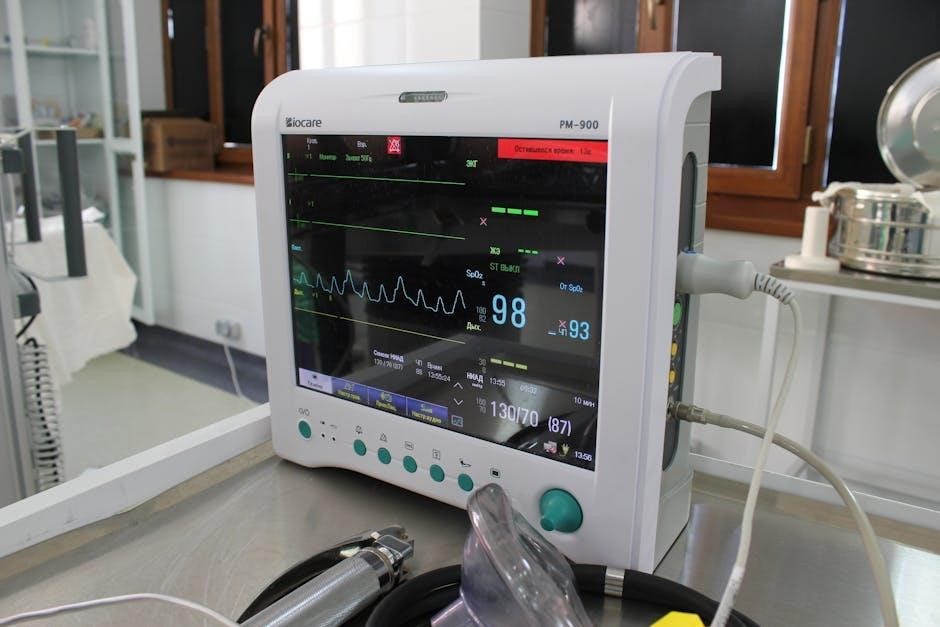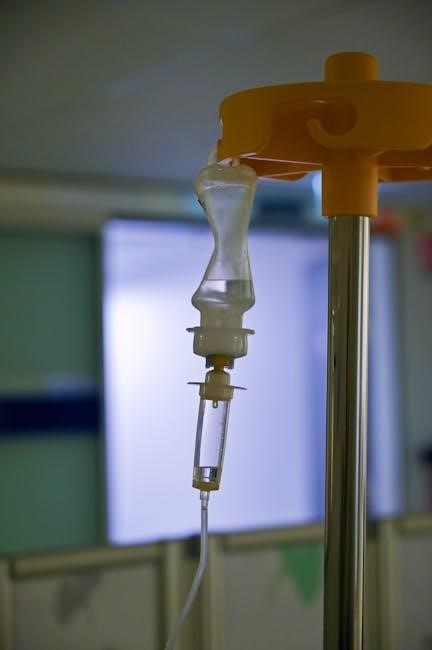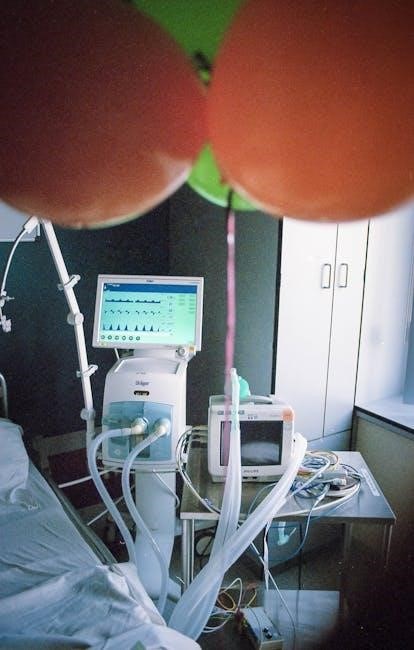ICU nursing involves caring for critically ill patients requiring close monitoring and life-sustaining interventions. Nurses in ICUs use advanced technology and skills to ensure optimal patient outcomes.
1.1 What is an ICU?
An Intensive Care Unit (ICU) is a specialized hospital department providing advanced care for critically ill or high-risk patients. Equipped with state-of-the-art technology, ICUs offer invasive and non-invasive monitoring to manage patients’ physiological variables. Nurses and medical teams deliver aggressive therapy, ensuring close observation and immediate interventions. The ICU environment is designed for patients requiring constant, life-sustaining support, such as mechanical ventilation or hemodynamic monitoring. It serves as a hub for complex medical interventions, focusing on stabilizing patients and improving outcomes in life-threatening conditions.
1.2 Role of Nurses in the ICU
ICU nurses play a critical role in delivering high-intensity care to critically ill patients. They are responsible for continuous monitoring, administering medications, and performing complex procedures. Nurses assess patients’ physiological variables, operate advanced equipment, and provide emotional support to families. Their expertise includes hemodynamic monitoring, respiratory support, and infection control. Collaboration with multidisciplinary teams is essential to develop and implement patient care plans. ICU nurses must remain vigilant, adapt to rapid changes, and prioritize patient safety. Their role is pivotal in stabilizing patients, managing life-threatening conditions, and improving clinical outcomes in a fast-paced, high-stakes environment.
1.3 Overview of ICU Patient Care
ICU patient care is highly specialized and focused on managing life-threatening conditions. It involves continuous monitoring of vital functions, such as heart rate, blood pressure, and oxygen levels. Nurses providevasive and non-invasive interventions, including mechanical ventilation and hemodynamic support. Patient care plans are tailored to address specific needs, such as pain management, nutrition, and infection control. Close collaboration with physicians and other healthcare professionals ensures comprehensive care. The goal is to stabilize patients, prevent complications, and promote recovery. ICU care also emphasizes family support and ethical considerations, ensuring holistic care in a high-acuity environment.

Key Concepts in ICU Nursing
Key concepts in ICU nursing include continuous patient assessment, advanced monitoring techniques, and life-sustaining interventions. These skills ensure optimal care for critically ill patients.
2.1 Basic Assessment and Monitoring
Basic assessment and monitoring in ICU involve evaluating vital signs, neurological status, and organ function. Nurses use tools like ECG and ABG analysis to guide care decisions, ensuring patient stability and early detection of complications. Regular monitoring helps in timely interventions, improving patient outcomes and reducing mortality rates in critical care settings.
2.2 Hemodynamic Monitoring
Hemodynamic monitoring in the ICU involves assessing a patient’s cardiovascular system to guide treatment. Tools like arterial lines and central venous catheters measure blood pressure, cardiac output, and fluid status. This data helps nurses and doctors optimize fluid resuscitation, vasopressor use, and cardiac support. Accurate interpretation of hemodynamic parameters is crucial for maintaining organ perfusion and preventing complications. Continuous monitoring allows for timely interventions, ensuring hemodynamic stability and improving patient outcomes in critical care settings. Regular assessments and adjustments are vital in managing critically ill patients with complex cardiovascular needs.
2.3 Respiratory and Cardiovascular Support
Respiratory and cardiovascular support are critical in ICU care. Nurses use mechanical ventilation to assist breathing, ensuring adequate oxygenation and ventilation. Cardiovascular support includes administering inotropes and vasopressors to maintain blood pressure and perfusion. Monitoring tools like pulse oximetry and capnography help assess respiratory status, while echocardiography and cardiac output monitoring guide cardiovascular interventions. Nurses must titrate therapies carefully, balancing support with potential complications. Continuous assessment and adjustment of these interventions are essential to optimize patient outcomes and prevent organ dysfunction in critically ill patients.

Common ICU Procedures
Common ICU procedures include vascular access, central line placement, and mechanical ventilation. These interventions are essential for monitoring and supporting critically ill patients effectively.
3.1 Vascular Access and Central Lines
Vascular access is crucial for administering medications and fluids in ICU patients. Central lines, such as central venous catheters, enable precise monitoring of hemodynamic parameters and delivery of vasoactive drugs. Proper insertion and maintenance are vital to prevent complications like infections or thrombosis. Nurses must follow strict sterile techniques during placement and ensure catheters are securely stabilized. Regular flushing and dressing changes are essential to maintain patency and reduce infection risks. Monitoring for signs of complications, such as swelling or redness, is critical for early intervention. Effective management of vascular access ensures patient safety and optimal care outcomes.
3.2 Mechanical Ventilation Basics
Mechanical ventilation is a life-saving intervention for patients with respiratory failure in the ICU. Nurses must understand the basics of ventilation modes, including volume and pressure-controlled settings. Proper patient assessment is essential to determine the need for intubation and ventilator support. Setting appropriate tidal volumes and respiratory rates ensures effective gas exchange while minimizing lung injury. Monitoring parameters like SpO2 and EtCO2 helps optimize ventilation. Regular suctioning and position changes prevent complications such as ventilator-associated pneumonia. Effective communication with the interdisciplinary team and continuous patient monitoring are critical for improving outcomes and weaning patients from mechanical ventilation successfully.
3.3 Inotropic and Vasoactive Medications
Inotropic and vasoactive medications are critical in managing hemodynamic instability in ICU patients. These drugs enhance cardiac contractility or alter vascular tone to optimize blood pressure and perfusion. Commonly used agents include dopamine, norepinephrine, and vasopressin. Nurses must monitor for therapeutic effects and potential side effects, such as tachycardia or ischemia. Proper titration and continuous monitoring of hemodynamic parameters are essential; Understanding the pharmacodynamics and patient-specific responses ensures safe and effective use. These medications are often titrated to maintain adequate organ perfusion and support the patient’s clinical condition.

Patient Care Skills
Patient care skills in the ICU include airway management, pain assessment, and nutritional support. These essential skills ensure optimal care and promote recovery in critically ill patients.
4.1 Airway Management
Airway management is critical in ICU nursing, focusing on ensuring patient airway patency and oxygenation. Techniques include endotracheal intubation, tracheostomy care, and suctioning. Proper assessment and intervention prevent complications like respiratory failure. Nurses must monitor for signs of airway obstruction and act swiftly. Regular evaluation of the Riker score is essential for mechanically ventilated patients. These skills are vital for maintaining patient stability and optimizing outcomes in critical care settings. Effective airway management is a cornerstone of ICU nursing practice.
4.2 Pain Management in ICU
Pain management in the ICU is essential to ensure patient comfort, reduce stress, and promote recovery. Nurses play a key role in assessing pain using tools like the Numerical Rating Scale or behavioral assessments for non-verbal patients. A multimodal approach is often employed, combining pharmacological agents such as opioids and non-opioids with non-pharmacological methods like relaxation techniques. Effective pain control improves patient outcomes, reduces agitation, and minimizes the need for sedation. Regular reassessment is crucial to tailor interventions to individual needs, ensuring balanced analgesia without compromising respiratory or neurological function. This holistic approach supports both physical and emotional well-being in critically ill patients.
4.3 Nutrition and Gastrointestinal Support
Nutrition and gastrointestinal (GI) support are critical for ICU patients to optimize recovery and prevent complications. Early enteral feeding is recommended to maintain gut integrity and reduce bacterial translocation. Nurses assess nutritional needs, often using tools like indirect calorimetry, and collaborate with dietitians to develop personalized plans. Parenteral nutrition is considered when the GI tract is non-functional. Monitoring for GI complications, such as stress ulcers or ileus, is essential. Prophylaxis with medications like histamine-2 receptor antagonists may be used to prevent stress-related mucosal bleeding. Nurses also manage feeding tubes, monitor for feeding intolerance, and ensure patients receive adequate nutrients to support healing and immune function.

Preventive Practices in ICU
Preventive practices in ICU focus on infection control, venous thromboembolism prophylaxis, and stress ulcer prevention. These measures ensure patient safety and reduce complications, tailored to individual needs.
5.1 Infection Control Measures
Infection control is critical in ICUs to prevent hospital-acquired infections. Proper hand hygiene, use of personal protective equipment (PPE), and sterile techniques during procedures are essential. Regular cleaning and disinfection of equipment and environments reduce pathogen transmission. Protocols for central line and ventilator-associated infections are strictly followed. Nurses play a key role in adhering to these measures, ensuring patient safety and minimizing infection risks in the high-acuity ICU setting.
5.2 Venous Thromboembolism Prophylaxis
Venous thromboembolism (VTE) prophylaxis is essential in ICU patients to prevent complications like deep vein thrombosis and pulmonary embolism. Nurses implement pharmacological measures, such as low-molecular-weight heparin, and mechanical methods, including intermittent compression devices. Patient assessment for VTE risk factors, like immobility or surgery, guides prophylaxis strategies. Regular monitoring for signs of VTE, such as swelling or shortness of breath, is crucial. Adherence to hospital protocols and guidelines ensures effective prevention, reducing morbidity and mortality in critically ill patients.
5.3 Stress Ulcer Prophylaxis
Stress ulcer prophylaxis is crucial in ICU patients to prevent gastrointestinal bleeding from stress-related mucosal damage. Nurses administer medications like proton pump inhibitors or histamine-2 receptor antagonists to reduce gastric acid production. Patients at higher risk, such as those on mechanical ventilation or with coagulopathy, benefit most from prophylaxis. Regular assessment of risk factors, like sepsis or shock, guides therapy; Monitoring for signs of bleeding, such as black stools or abdominal pain, is essential. Adherence to guidelines ensures effective prevention while minimizing complications like Clostridioides difficile infections. Proper documentation and adjustment of therapy based on patient response are key nursing responsibilities.

Advanced Monitoring Techniques
Advanced monitoring in ICUs includes arterial blood gas analysis, cardiac output measurement, and renal function assessment. These tools help nurses optimize patient care and detect complications early.
6.1 Arterial Blood Gas Analysis
Arterial blood gas (ABG) analysis is a critical tool in ICU nursing, providing essential data on oxygenation, ventilation, and acid-base balance. It measures pH, PaO2, and PaCO2 levels, helping nurses assess respiratory and metabolic status. ABGs guide interventions like ventilator adjustments, oxygen therapy, and fluid management. Nurses must interpret results accurately, considering the patient’s clinical condition. Regular ABG monitoring ensures timely detection of changes, enabling proactive care. Proper sample collection and handling are vital for accurate results. ABG analysis is a cornerstone of ICU care, aiding in optimizing patient outcomes and managing complex physiological challenges effectively.
6.2 Cardiac Output Monitoring
Cardiac output (CO) monitoring in the ICU assesses the heart’s ability to pump blood, crucial for managing critically ill patients. Techniques include the Fick method, thermodilution, and pulse contour analysis. Accurate CO measurement helps guide fluid resuscitation, vasopressor use, and inotropic therapy. It is essential for optimizing tissue perfusion and preventing complications. Nurses must interpret CO values in the context of the patient’s condition, ensuring interventions align with hemodynamic goals. Continuous monitoring aids in early detection of changes, enabling timely adjustments to support cardiac function and improve patient outcomes.
6.3 Renal Function and Urine Output Monitoring
Monitoring renal function and urine output is critical in ICU nursing to assess fluid balance and kidney performance. Nurses measure urine output to detect acute kidney injury or failure, aiming for at least 0.5 mL/kg/hour. Blood urea nitrogen (BUN) and creatinine levels are also evaluated. Factors such as fluid status, medications, and blood pressure can impact renal function. Accurate documentation and early intervention are essential to prevent complications. Continuous assessment ensures timely adjustments in treatment, supporting optimal patient outcomes and maintaining electrolyte balance. This monitoring is vital for managing critically ill patients and guiding renal replacement therapy when needed.

Ethical and Legal Considerations
ICU nursing involves ethical dilemmas, such as end-of-life decisions and patient autonomy. Legal aspects include accurate documentation and adherence to patient rights, ensuring informed consent and privacy.
7.1 End-of-Life Care in ICU
End-of-life care in the ICU focuses on compassion and dignity, ensuring patients’ wishes are respected. Nurses play a vital role in palliative care, managing pain and emotional support for families. Communication with patients and families is crucial, addressing their concerns and providing comfort. Legal and ethical considerations must be upheld, including advance directives and do-not-resuscitate orders. Nurses must balance medical interventions with quality-of-life concerns, ensuring a peaceful and respectful transition for patients nearing the end of life.
7.2 Informed Consent and Patient Rights
Informed consent ensures patients are fully aware of their treatment options, risks, and benefits. Nurses must respect patient autonomy, ensuring decisions are made voluntarily. Patient rights include confidentiality, dignity, and access to medical records. In the ICU, patients or their surrogates must provide consent for invasive procedures. Nurses act as advocates, ensuring patients’ wishes are honored. Legal documentation is essential to validate consent, protecting both patients and healthcare providers. Understanding these principles is vital for ethical practice in critical care settings, fostering trust and upholding patient-centered care.

7.3 Documentation and Legal Aspects
Accurate and thorough documentation is crucial in ICU nursing for legal protection and continuity of care. Nurses must record all patient interactions, treatments, and changes in condition. Legal aspects include maintaining patient confidentiality and adhering to privacy laws. Documentation serves as a permanent record, detailing the care provided and supporting clinical decisions. Inaccurate or incomplete records can lead to legal consequences. Nurses should follow hospital policies and legal standards to ensure compliance. Proper documentation also helps in defending care practices if questions arise, making it a cornerstone of professional nursing responsibility in the ICU setting.

Communication and Teamwork
Effective communication is vital in ICU nursing, ensuring patient safety and proper care coordination among healthcare teams. Clear dialogue supports accurate decision-making and collaborative patient management.
8.1 Effective Communication with Patients and Families
Effective communication with patients and families is crucial in ICU nursing, fostering trust and understanding. Nurses must empathetically address concerns, provide clear updates, and involve families in care decisions while respecting cultural and emotional needs. Active listening and compassion are essential, especially during stressful moments. Ensuring patients and families are well-informed supports shared decision-making and alleviates anxiety. Documentation of interactions is vital for legal and continuity of care. Clear, honest communication helps families navigate critical situations, ensuring patient-centered care and maintaining ethical standards in intensive care settings.
8.2 Interdisciplinary Collaboration
Interdisciplinary collaboration is vital in ICU settings, where complex patient care requires teamwork. Nurses work alongside physicians, respiratory therapists, and other specialists to ensure comprehensive care. Effective communication and mutual respect within the team optimize patient outcomes. Regular rounds and case discussions facilitate coordination, while delegated tasks ensure efficient workflow. Collaboration also enhances problem-solving, as diverse expertise addresses critical issues. Building trust and open dialogue among team members fosters a supportive environment, ultimately improving patient care quality and safety in high-stakes ICU environments.
8.3 Handover and Reporting in ICU
Effective handover and reporting are critical in ICU to ensure continuity of care. Nurses must communicate patient status, treatment plans, and concerns clearly during shift changes. Standardized tools like I-PASS or handoff checklists can reduce errors. Accurate documentation in patient records is essential for legal and care coordination purposes. Verbal reports should be concise, focusing on key data such as vital signs, medications, and recent changes. Timely reporting of critical issues to the interdisciplinary team ensures prompt interventions. Proper handover minimizes risks, enhances patient safety, and maintains seamless care delivery in dynamic ICU environments.

Emergency Situations in ICU
ICU nurses must manage emergencies like code blue, cardiac arrest, seizures, and rapid response situations. Prompt interventions, adhering to ACLS and hospital protocols, are critical for patient survival.
9.1 Code Blue and Cardiac Arrest Management
In the ICU, Code Blue situations require immediate action. Nurses must promptly identify cardiac arrest and initiate ACLS protocols. High-quality CPR, defibrillation, and medication administration are critical. Effective communication and teamwork ensure synchronized interventions. Post-arrest care focuses on stabilizing the patient and preventing further complications. Documentation of events and outcomes is essential for continuous improvement. Nurses play a vital role in managing these emergencies, adhering to hospital protocols, and ensuring patient safety. Their expertise and quick decision-making are paramount in such high-stakes situations.
9.2 Seizure Management
In the ICU, seizure management is critical to prevent neurological deterioration. Nurses must rapidly assess the patient, ensuring airway protection and vital sign stability. Administering antiepileptic medications as prescribed is essential. Continuous EEG monitoring may be required to detect seizure activity. Post-seizure care includes evaluating the cause and preventing recurrence. Environmental adjustments, such as reducing stimuli, can aid recovery. Nurses play a key role in recognizing seizure patterns and collaborating with the interdisciplinary team to optimize patient outcomes. Prompt and precise interventions are vital to manage seizures effectively in the ICU setting and improve patient safety.
9.3 Rapid Response Systems
Rapid Response Systems (RRS) are crucial for early intervention in deteriorating ICU patients. These systems enable quick assembly of interdisciplinary teams to assess and stabilize patients outside traditional hierarchies. Nurses play a pivotal role in activating RRS when they identify critical changes in a patient’s condition. Timely communication and collaboration ensure effective implementation of life-saving measures. RRS enhances patient safety by reducing delays in care and improving outcomes. Regular training and education for ICU staff are essential to maintain the effectiveness of these systems. The goal is to intervene early and prevent complications, ensuring optimal patient care in critical situations.
10.1 Summary of Key Concepts
Effective ICU nursing hinges on mastering critical care skills, including patient assessment, hemodynamic monitoring, and respiratory support. Proficiency in vascular access, pain management, and infection control is essential. Nurses must stay updated on evidence-based guidelines and adapt to emerging practices. Continuous learning and interdisciplinary collaboration enhance patient outcomes. Documentation and ethical considerations remain cornerstone responsibilities. By integrating these key concepts, nurses provide compassionate and high-quality care in dynamic ICU environments, ensuring optimal recovery and dignity for critically ill patients.
10.2 Continuous Learning and Professional Development
Continuous learning is vital for ICU nurses to stay updated on evidence-based practices and advanced technologies. Certifications like CCRN validate expertise, while resources such as AACN Essentials and The Little ICU Book provide foundational knowledge. Engaging in workshops, simulations, and online courses enhances critical care skills. Mentorship programs and interdisciplinary collaboration foster professional growth. Staying informed about emerging trends ensures nurses deliver cutting-edge care. By prioritizing lifelong learning, ICU nurses maintain high standards of patient care and adapt to evolving challenges in critical care settings.